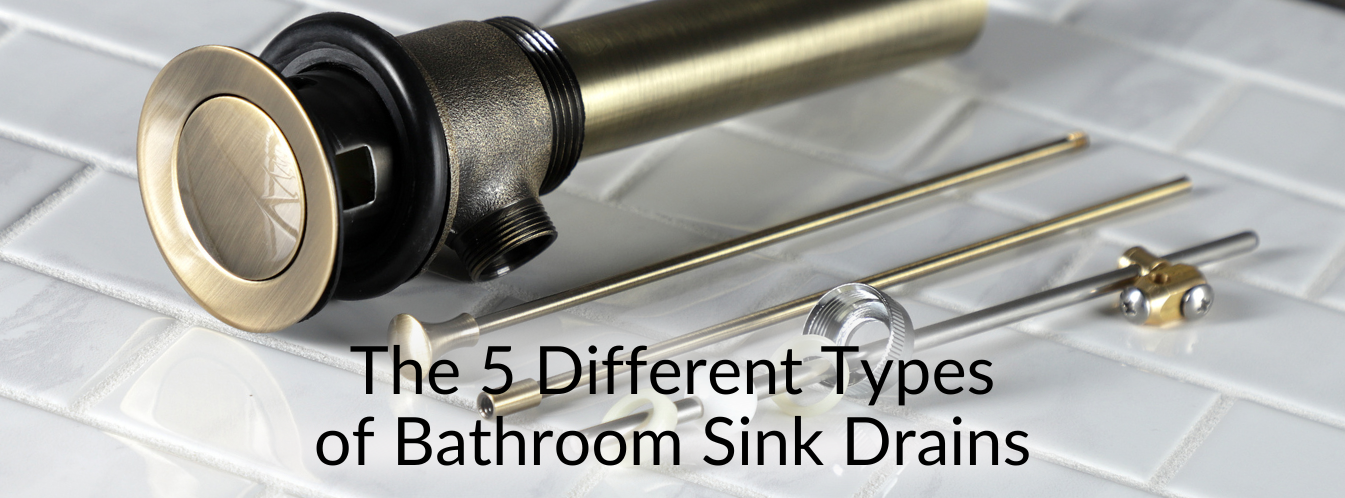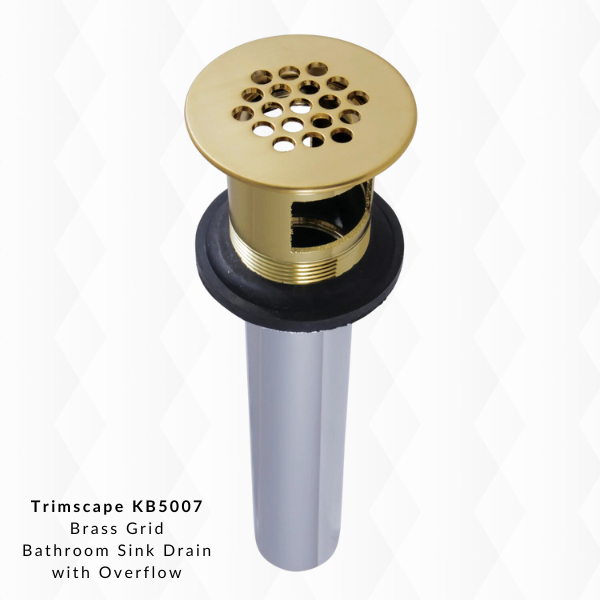Get PRO Pricing
Get [PRO] Pricing

Even the smallest details in bathroom design, like a sink drain, can make a big difference in how everything looks and works. There are a variety of drain types you can choose from depending on your specific sink setup. We'll break down what makes each type unique, so you can pick the perfect fit for your sink without any stress.
Nowadays, sink drains aren't just about functionality; they're also about adding a touch of style to your bathroom. One way to beautify your drains is by matching them to the color finish of your faucet or surrounding hardware. Whether you prefer sleek polished chrome, trendy matte black, or classic polished brass, there's a matching finish available for your drain. All of Kingston’s color finishes are premium quality and designer-compatible.
Push pop-up drains operate with a simple yet ingenious mechanism. When you press down on the stopper, it seals the drain, preventing water from flowing through. Conversely, another press releases the stopper, allowing water to drain away. Their user-friendly design makes them perfect for bathrooms where convenience is key. One major advantage is their sleek appearance and easy maintenance. They're ideal for households looking to add a contemporary touch to their sink setup without sacrificing functionality. Push pop-up drains are especially useful in busy bathrooms where quick and effortless drainage is essential.
Pop-up rod drains operate through a straightforward mechanism connected to a rod linked to the faucet. When the rod is lifted or lowered, it controls the opening and closing of the drain stopper, allowing users to adjust as needed. Their traditional design makes them a popular choice for various bathroom styles. One advantage is their manual operation, providing precise control over drainage. Pop-up rod drains are particularly suitable for bathrooms where a traditional or vintage look is desired, adding a touch of elegance to the space.
Grid drains function by featuring a grid or grate-like surface that serves as a barrier to prevent large debris from entering the drainpipe while allowing water to flow freely. Their design efficiently captures hair, soap scum, and other particles, reducing the likelihood of clogs and drainage issues. The grid style also helps keep your small valuables from getting lost down the drain. One significant advantage is their effective debris filtration and easy maintenance. They are ideal for bathrooms where cleanliness and efficiency are priorities, as they help keep the drainpipe clear and prevent plumbing problems. Grid drains are particularly suitable for households with individuals who shed a lot of hair or use products that may lead to debris buildup, ensuring uninterrupted water flow and hassle-free maintenance.
Lift and turn drains operate through a simple yet reliable mechanism, where users manually lift or turn the stopper to open or close the drain. They are ideal for bathrooms where durability and user control are needed, offering dependable everyday sink use. Lift and turn drains are particularly suitable for households seeking a straightforward and low-maintenance drain option that complements various bathroom styles.
Chain and plug drains are a well-known and classic option for controlling water flow in bathroom sinks. A plug attached to a chain is manually operated to open and close the drain. One advantage of chain and plug drains is their simplicity and durability, making them a reliable choice for those who appreciate traditional craftsmanship. Chain and plug drains are particularly suitable for homeowners seeking a vintage or traditional design.
Bathroom sink stoppers equipped with an overflow or overflow hole serve as an additional safeguard against water overflow and potential flooding. The overflow hole is typically located near the top of the sink bowl and connects to the drainpipe, allowing excess water to drain out if the sink starts to overflow.
There are a variety of drain materials you can choose from, but a solid brass construction will last much longer than a plastic-composed drain. A solid brass drain will offer longevity and durability, qualities that make home fixtures reliable.
Sink drains come in various sizes to accommodate different types of sinks and plumbing configurations. The most common size for bathroom sink drains is 1 1/4 inches. The size of the drain is typically determined by the diameter of the drain opening in the sink and the corresponding plumbing fittings. 1-1/4 inch drains fit the standard 1-5/8 inch drain opening. Smaller sinks, such as those found in bathrooms or bar areas, typically use 1 1/4-inch drains, while larger sinks, such as kitchen sinks, typically require 1 1/2-inch drains to accommodate greater water flow. Additionally, some specialty sinks or custom installations may require larger 2-inch drains to handle increased drainage capacity.

To find your sink’s drain size, start by measuring the diameter of the drain opening in your sink. This measurement will help you identify the size of the drain assembly needed to fit your sink properly. Additionally, consider the depth of your sink and the type of drain you plan to install, as these factors can also influence the size requirements. If you're unsure about the correct size, consult the manufacturer's specifications or seek advice from a professional plumber to ensure you select the appropriate drain size for your sink.
Some sink drain assemblies may need a slip joint extension tube to assist a drain stem in reaching the proper outlet hole. Learn about how to extend a sink drain with a slip joint extension tube.
Regular cleaning of your sink drain is key, and this can be done by removing the drain stopper and using a drain brush or plumber's snake to clear away any accumulated hair, soap scum, or debris. Running hot water down the drain periodically can help dissolve buildup and keep the pipes clear. Additionally, it's a good idea to avoid pouring grease, oil, or harsh chemicals down the drain, as these can contribute to clogs and damage the pipes. For routine maintenance, a mixture of baking soda and vinegar can be poured down the drain followed by hot water to help remove buildup and keep the drain smelling fresh. If clogs persist despite regular maintenance, using a plunger or commercial drain cleaner may be necessary. However, for stubborn clogs or more serious plumbing issues, it's best to consult a professional plumber for assistance.




















